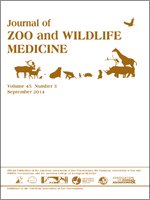A 1-yr-old female Canada lynx (Lynx canadensis) presented for sudden onset of rapidly progressive bilateral pelvic limb paralysis. The lynx was chemically immobilized to perform a physical examination but expired shortly thereafter. On postmortem radiographs, there were myriad small irregular, round-to-spherical gas densities within the skeletal muscle of the right thigh and epaxial musculature. At gross necropsy, the muscles of the right thigh, right lateral abdominal wall, and epaxial region were emphysematous and necrohemorrhagic, with subcutaneous and muscular crepitant swelling. Multiple skin puncture wounds, consistent with bites, were present over the affected tissues. Clostridium septicum was isolated in pure anaerobic culture from the musculature of the right hind limb. Histopathologic examination confirmed the diagnosis of acute, severe necrohemorrhagic and gangrenous myositis and cellulitis. Gram stains demonstrated large gram-positive bacilli with subterminal spores. This is the first known documented case of C. septicum myonecrosis in a nondomestic felid.
How to translate text using browser tools
1 September 2014
FATAL CLOSTRIDIUM SEPTICUM MYONECROSIS IN A CAPTIVE CANADA LYNX (LYNX CANADENSIS)
Jenelle M. Izer,
Ronald P. Wilson,
Timothy K. Cooper
ACCESS THE FULL ARTICLE
Canada lynx
Clostridium septicum
gas gangrene
hind limb paralysis
Lynx canadensis
myonecrosis





